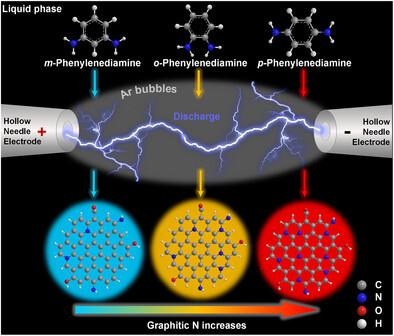气液重复脉冲放电合成多色发光碳点:石墨氮的作用
IF 12.1
2区 材料科学
Q1 CHEMISTRY, MULTIDISCIPLINARY
引用次数: 0
摘要
近年来,多色发射碳点(cd)因其在不同学科领域的广泛应用而受到广泛关注。尽管取得了重大进展,但开发有效的制造策略和了解荧光调制机制仍然面临相当大的挑战。本文报道了一种快速可控的通过气液放电制备荧光可调CDs的方法。通过对间苯二胺、邻苯二胺和对苯二胺水溶液的放电处理,在20分钟内成功制备出明亮的青色、黄色和红色发光CDs。这三种类型的CDs具有相似的平均粒径4-6 nm,它们的表面被羟基、羰基、氨基N和石墨N功能化,傅里叶变换红外(FTIR)和x射线光电子能谱(XPS)分析表明,表面状态主要控制多色发射碳点的荧光行为。N诱导表面态的定量分析和DFT计算表明,荧光可调机制归因于石墨N含量的增加。由于其多色发射,合成的荧光可调cd在荧光薄膜和LED器件等应用中表现优异。本研究为选择不同的苯二胺异构体制备不同的CDs提供了一条途径。本文章由计算机程序翻译,如有差异,请以英文原文为准。

Controllable Synthesis of Multicolor-Light-Emitting Carbon Dots via Gas–Liquid Repetitive Pulsed Discharges: The Role of Graphitic Nitrogen
In recent years, multicolor-emissive carbon dots (CDs) have garnered widespread attention owing to their versatile applications across diverse disciplines. Despite significant progress, developing efficient fabrication strategies and understanding fluorescence modulation mechanisms still pose considerable challenges. Herein, a fast and controllable method is reported to produce fluorescence-tunable CDs through gas–liquid discharge. Bright cyan, yellow, and red-emitting CDs are successfully prepared within 20 min via discharge treatment of m-phenylenediamine, o-phenylenediamine, and p-phenylenediamine aqueous solutions. These three types of CDs have similar average particle sizes of 4–6 nm, and their surfaces are functionalized with hydroxyl, carbonyl, amino N, and graphitic N. Fourier transform infrared (FTIR) and X-ray photoelectron spectroscopy (XPS) analyses reveal that surface states primarily govern the fluorescence behavior of multicolor-emissive carbon dots. Quantitative analysis of N-induced surface states and DFT calculations demonstrate that the fluorescence-tunable mechanism is attributed to increased graphitic N content. Owing to their multicolor emissions, the synthesized fluorescence-tunable CDs excel in applications such as fluorescent films and LED devices. This work offers a pathway for fabricating diverse CDs by selecting various phenylenediamine isomers.
求助全文
通过发布文献求助,成功后即可免费获取论文全文。
去求助
来源期刊

Small
工程技术-材料科学:综合
CiteScore
17.70
自引率
3.80%
发文量
1830
审稿时长
2.1 months
期刊介绍:
Small serves as an exceptional platform for both experimental and theoretical studies in fundamental and applied interdisciplinary research at the nano- and microscale. The journal offers a compelling mix of peer-reviewed Research Articles, Reviews, Perspectives, and Comments.
With a remarkable 2022 Journal Impact Factor of 13.3 (Journal Citation Reports from Clarivate Analytics, 2023), Small remains among the top multidisciplinary journals, covering a wide range of topics at the interface of materials science, chemistry, physics, engineering, medicine, and biology.
Small's readership includes biochemists, biologists, biomedical scientists, chemists, engineers, information technologists, materials scientists, physicists, and theoreticians alike.
 求助内容:
求助内容: 应助结果提醒方式:
应助结果提醒方式:


